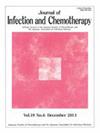鉴定恶性肿瘤患者肾造瘘管相关性肾盂肾炎的致病微生物和非致病微生物
IF 1.9
4区 医学
Q3 INFECTIOUS DISEASES
引用次数: 0
摘要
背景:长期安装肾造瘘管会导致各种微生物在管腔内定植,从而引发肾造瘘管相关性肾盂肾炎(NTAP)。恶性肿瘤患者通常需要长期安装肾造瘘管,因此很容易患上 NTAP。然而,有关这类人群 NTAP 特征的信息却很有限:我们回顾了一家癌症中心 43 例恶性肿瘤患者的 NTAP 病例,并对尿液培养中检测到的致病微生物和非致病微生物进行了研究。致病微生物定义为:(1) 在尿液和血液培养中同时检测到的微生物;或 (2) 在单菌尿液培养中检测到的微生物,且医生对其使用有效抗菌药物≥ 5 天。非致病微生物的定义是:使用有效抗菌药物的时间总计小于 5 天的微生物:结果:43 例 NTAP 中的 42 例患者在抗菌治疗≥ 7 天后痊愈。在 25 个病例中确定了致病微生物,其中以大肠埃希菌和肺炎克雷伯菌最为常见。尿液培养中检测到的除粪肠球菌以外的所有肠球菌、棒状杆菌、白色念珠菌以外的念珠菌以及大多数嗜麦芽血单胞菌被认为不是 NTAP 的致病微生物:结论:大肠杆菌是引起该人群NTAP的常见微生物。结论:大肠杆菌是导致该人群 NTAP 的常见病菌,对头孢菌素耐药的几种微生物不是 NTAP 的致病菌,即使在尿培养中检测到这些微生物,也没有必要使用抗菌药物。本文章由计算机程序翻译,如有差异,请以英文原文为准。
Identification of causative and non-causative microorganisms of nephrostomy tube-associated pyelonephritis among patients with malignancy
Background
Prolonged installation of a nephrostomy tube causes colonization of various microorganisms within the lumen of the tube, leading to the development of nephrostomy tube-associated pyelonephritis (NTAP). Patients with malignancy, often necessitating long-term installation of a nephrostomy tube, are susceptible to NTAP. However, information regarding the characteristics of NTAP in this population is limited.
Methods
We reviewed 43 NTAP cases of patients with malignancy in a cancer center and examined causative and non-causative microorganisms among those detected in urine culture. Causative microorganisms were defined as (1) those detected simultaneously in urine and blood cultures or (2) those detected in monomicrobial urine culture and to which physicians administered active antimicrobials for ≥5 days. Non-causative microorganisms were defined as those to which active antimicrobials were given for a total of <5 days.
Results
Patients in 42 of the 43 NTAP cases recovered with antimicrobial therapy for ≥7 days. Causative microorganisms were identified in 25 cases, where Escherichia coli and Klebsiella pneumoniae were most frequent. All enterococci other than Enterococcus faecalis, Corynebacterium species, and Candida species other than Candida albicans and most of Stenotrophomonas maltophilia detected in urine culture were considered non-causative of NTAP.
Conclusion
E. coli was a common organism causing NTAP of this population. Several microorganisms resistant to cephalosporin were non-causative of NTAP, for which administration of antimicrobials may be unnecessary even if detected in urine culture.
求助全文
通过发布文献求助,成功后即可免费获取论文全文。
去求助
来源期刊

Journal of Infection and Chemotherapy
INFECTIOUS DISEASES-PHARMACOLOGY & PHARMACY
CiteScore
4.10
自引率
4.50%
发文量
303
审稿时长
47 days
期刊介绍:
The Journal of Infection and Chemotherapy (JIC) — official journal of the Japanese Society of Chemotherapy and The Japanese Association for Infectious Diseases — welcomes original papers, laboratory or clinical, as well as case reports, notes, committee reports, surveillance and guidelines from all parts of the world on all aspects of chemotherapy, covering the pathogenesis, diagnosis, treatment, and control of infection, including treatment with anticancer drugs. Experimental studies on animal models and pharmacokinetics, and reports on epidemiology and clinical trials are particularly welcome.
 求助内容:
求助内容: 应助结果提醒方式:
应助结果提醒方式:


